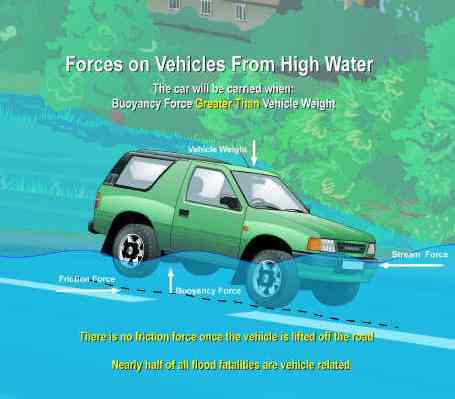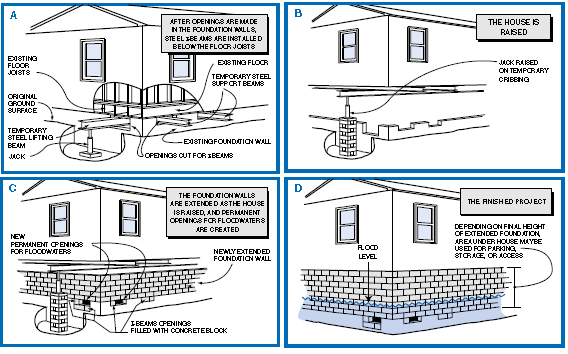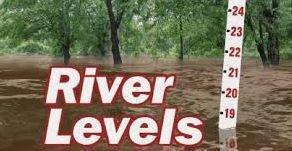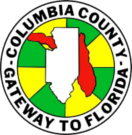 Columbia County, FL uses javascript to enhance its website and provide the public with useful features.
Columbia County, FL uses javascript to enhance its website and provide the public with useful features.Because of this, many features will not work. Please enable javascript in your browser to get the best possible experience while on our site.
Flood Information
Flood Maps and Elevation Certificates
The Building and Zoning Department maintains elevation certificates submitted for permitted structures within Columbia County. We have paper copies of the Flood Insurance Rate Maps (FIRM) aka: FEMA Flood Maps or digital aerial printouts. You may contact Brandon Stubbs, County Planner by calling 386-754-7119 or Liza Williams by calling 386-719-1474 or by visiting our office.Page Contents
1) The Local Flood Hazard
2) The Flood Warning System
3) Columbia County Emergency Operations Center
4) Flood Safety Measures
5) Flood Insurance
6) Natural and Beneficial Functions of the Flood Plain
7) Community Rating System
8) Property Protection Measures
9) Floodplain Development Permit Requirements
10) Substantial Improvement Requirements
11) Drainage System Maintenance
12) After the Flood
Download the Columbia County Flood Facts and Preparedness Manual with Checklists
The Local Flood Hazard
In Columbia County, the primary threat of flooding results from the ponding of water during heavy storms and the Suwannee and Santa Fe rivers reaching flood stage. Some flooding can result from overflow of small ditches and streams during significant storm events. Since Columbia County is relatively flat with low-lying areas, storm water sometimes simply overwhelms street drainage and water retention areas. Leaves and other debris can clog storm drains, culverts, and drainage swales, causing water to back up into lower-lying areas. Residents are encouraged not to blow yard waste (i.e. grass clippings, leaves, and small branches) into the street to prevent clogging of the storm water grates, culverts, and other similar devices. County floods of record have occurred in 1928, 1948, 1959, 1964, 1973, 1984, 1986, 1991, and 1998. High water data for these events is available from the Suwannee River Water Management District at (386) 362-1001.
The Flood Warning System
In the event of a major storm, Columbia County receives notification from the Emergency Operations Center and certain County departments are put on alert. Local news media sources (radio and television) are notified and distribute instructions to the public. If needed, the Columbia County Fire and Sheriff Departments may notify area residents by door-to-door personal contact, telephone, and use of sirens and public address systems. During significant storms, the Sheriff's Department and Fire Department monitor storm updates and pass information on to media sources for distribution.
COLUMBIA COUNTY EMERGENCY OPERATIONS CENTER (EOC) www.columbiacountyem.com
Use the Columbia County Emergency Operations Center web site to locate storm information, alerts and helpful information before a disaster happens. Columbia County Emergency Operations Center (386-719-7530) works with the National Weather Service and the National Hurricane Center to monitor flood and storm threats and advises the community accordingly. When a storm or flood threatens to impact the County, County staff monitors the event relying on information from various officials and the National Weather Service for detailed and site specific information regarding storm conditions and flood threats. The National Weather Service issues updates, warnings, and evacuation notice.
The following stations service the Columbia County area:
Radio: WDSR-FM 1340, WJTK-FM 96.5, WCJX-FM 106.5, and WNFB-FM 94.3,
Satellite TV Channels: 4, 12, 25, 30, and 47 and Cable TV Channels: 6, 8 and WCJB TV20
Report yourself as Safe and Well to family and friends.
If you have been affected by a disaster, this website provides a way for you to register yourself as "safe and well. From a list of standard messages, you can select those that you want to communicate to your family members, letting them know of your well-being.
Two main functions:
1) List yourself as Safe and Well: Person/Family affected by a disaster creates a safe and well registration for them.
2) Search: Concerned loved ones anywhere search for the messages posted by those who self-registered.
To access the Safe and Well Website go to:
safeandwell.communityos.org or call
1-866-GET-INFO.
Americans with Disabilities Act Working Group
This information is being provided to you via the ADA Working Group's Clearinghouse on Disability Information.
We hope this information is helpful to you.
FLOOD SAFETY MEASURES
You can protect yourself from flood hazards by taking measures to ensure the safety of life and property before, during, and after a flood occurs.
Be prepared before a flood. Copy your most important documents and store originals in a safe place outside the home. Take photos of your most valuable possessions and store copies with other documents. Make an itemized list of other possessions. Store receipts for any expensive household items where they will not be destroyed.
Have an emergency plan. Provide your insurance agent, employer, and family with emergency contact information. Put aside an emergency kit equipped with a large flashlight, batteries, candles, waterproof matches and a battery operated radio. Keep a minimum 3-day supply of non-perishable food and water on hand. Visit www.fema.gov and www.ready.gov for more information.
Stay informed. Turn on a battery operated radio or television to get the latest emergency information. Continue listening to the radio for news about what to do, where to go, and places to avoid.
If evacuation becomes necessary, do so immediately. Be sure that you turn off all utility services at the main connection.
Do not walk through flowing water. Drowning is the number one cause of flood deaths, mostly during flash floods. Currents can be deceptive; six inches of moving water can knock you off your feet. If you walk in standing water, use a pole or stick to see how deep the water is.
Do not drive through a flooded area. More people drown in their cars than anywhere else. Do not drive around road barriers; the road or bridges further down the road may be washed out. Two feet of moving water can sweep your car away.
TURN AROUND, DON'T DROWN

Stay away from power lines and electrical wires. The number two flood killer after drowning is electrocution. Electric current can travel through water. Report downed power lines to your Power Company or County Emergency Operations Center at 386-719-7530.
Be alert for gas leaks. Do not smoke or burn candles or lanterns. Gas is easily ignited. In a flood, be sure your gas is turned off by the gas company.
Look out for animals, especially snakes.Small animals may seek shelter in your home.
Don't leave pets behind.If you cannot take your pets with you please contact the Animal Shelter at 386-752-3191 to make arrangements for your pets.
FLOOD INSURANCE
In all 50 states on coasts, mountains, along rivers, in the desert, in towns, and cities of every size, floods happen. Your home has a 26% chance of being damaged by a flood over the life of a 30-yr. mortgage.
For many people, their home and its contents represent their greatest investment. Property losses due to flooding are not covered under most standard homeowner's insurance policies. You can protect your home and its contents with flood insurance through the National Flood Insurance Program (NFIP.)
The NFIP is a federal program established by Congress in 1968 which enables property owners to buy flood insurance at reasonable rates in participating communities. In return, participating communities carry out flood management measures designed to protect life and property from future flooding.
The NFIP is administered by the Federal Emergency Management Agency through its Federal Insurance Administration. Columbia County has participated in the NFIP since 1996. The Columbia County NFIP community number is 120070.
Flood insurance from the NFIP puts you in control. You won't have to wait in line to apply for disaster assistance. Homeowners, business owners, and renters all can buy flood insurance, as long as their community participates in the NFIP.
Flood insurance claims are paid even if a disaster is not declared by the President. NFIP claims are paid promptly, so flood victims can recover quickly. If you file a flood insurance claim, you may request an advance partial payment for your immediate needs.
Flood insurance reimburses you for all covered losses. Homeowners can buy up to $250,000 of coverage. Separate contents coverage is available up to $100,000 for homeowner's and renters.
To find out more about flood insurance for your property and its contents, contact your insurance agent. There is usually a 30-day waiting period before a flood insurance policy takes effect, so don't wait until a storm threatens before you secure the flood insurance you need. For more information about the NFIP and flood insurance, call
1-866-277-0055. To assess your risk, visit
www.floodsmart.com.
NATURAL AND BENEFICIAL FUNCTIONS OF THE FLOOD PLAIN
These benefits take many forms:
1. Natural flood and erosion control---providing flood storage and conveyance, reduce flood velocity,
controls erosion of beachfront or riverfront structures.
2. Water quality---filters nutrients and impurities from runoff.
3. Ground water recharge---reduces frequency and duration of surface flow.
4. Biological resources---supports high rate of plant growth, provides breeding and feeding grounds and
enhances water fowl habitat.
5. Societal resources---provides open space and aesthetic pleasures, and in areas of scientific study, provides opportunities for environmental research.
COMMUNITY RATING SYSTEM
Columbia County participates in the Community Rating System (CRS), a part of the National Flood Insurance Program (NFIP), which provides a mechanism for reducing flood insurance premiums to reflect what a community does beyond the NFIP's minimum requirements. The CRS is a voluntary incentive program that rewards community actions that reduce flood risk through discounted flood insurance rates.
PROPERTY PROTECTION MEASURES
Every year, flooding causes more property damage in the United States than any other type of natural disaster. While recent construction practices and regulations have made new homes less prone to flooding, many existing structures remain susceptible. Throughout the country there is a growing interest from property owners to develop practical and cost effective methods for reducing or eliminating exposures to flooding. Several effective ways include acquisition and relocation of a building to a site not subject to flooding, construction of floodwalls or berms to keep water away from the property, or retrofitting structures to make them flood proof. Retrofitting is a different approach from the other ways because the property itself remains subject to flooding while the building is modified to prevent or minimize flooding of habitable space.
There are several recognizable approaches to retrofitting:
1. Elevation of the structure above flood protection levels.
(see diagram A,B,C,& D below)
2. Construction of barriers (floodwalls, berms.)
3. Dry flood proofing (water tight floor and wall systems.)
4. Wet flood proofing (permits entry and passage of flood waters.)
In the event of pending flood threats it is always advisable to take the following emergency actions:
1. Sand bagging to reduce erosion and scouring.
2. Elevate furniture above flood protection levels.
3. Create floodway openings in non-habitable areas such as garage doors.
4. Seal off sewer lines to the dwelling to prevent the backflow of sewer waters.

FLOODPLAIN DEVELOPMENT PERMIT REQUIREMENTS
Any development in the floodplain requires a building permit according to Article 8 of Columbia County Land Development Regulations. To obtain a flood zone determination, contact the Columbia County Building and Zoning Department at 386-754-7119, or online at www.srwmdfloodreport.com. Copies of Elevation Certificates for all buildings constructed in the floodplain since June, 2004 are available in the Building and Zoning Department. If you witness development that has not been permitted please contact Columbia County Code Enforcement at (386)-758-1038.
SUBSTANTIAL IMPROVEMENT REQUIREMENTS
Columbia County requires that if the cost of reconstruction, rehabilitation, addition, or other improvements to a building equals or exceeds 50% of the building's value, the building must meet the same construction requirements as a new building. Substantially damaged buildings must also be brought up to the same standards (e.g., a residence damaged where the cost of repairs equals or exceeds 50% of the building's value before it was damaged must be elevated above the base flood elevation.) The building's value shall be determined before the improvement is started, or if the structure has been damaged and is being restored, before the damage or destruction occurred.
DRAINAGE SYSTEM MAINTENANCE
A community can lose a portion of its drainage system carrying or storage capacity due to dumping, debris, soil erosion and sedimentation, and overgrowth of vegetation. When this happens, flooding occurs more frequently and reaches higher elevations, subjecting properties otherwise protected to unnecessary risk of damage. Keep grass clippings and other debris out of storm water drainage systems to prevent clogging and loss of storm water storage and treatment capacity.
If you experience or are aware of any localized drainage problems, including illegal stream dumping, please notify the Columbia County Public Works at
386-758-1019 so that the problem may be corrected.
AFTER THE FLOOD
Protect yourself and your family from the stress, fatigue, and health hazards that follow a flood:
1. Dry out your home. Floodwaters damage most materials and leave mud, silt and unknown contaminants that promote the growth of mold and mildew.
2. Restore the utilities. The rest of your work will be much easier if you have electricity, clean water, and sewage disposal.
3. Clean up. The walls, floors, closets, shelves, contents, and any other flooded parts of your home should be thoroughly washed and disinfected.
4. Rebuild and flood proof. Take your time to rebuild correctly and make improvements that will protect your building from damage by the next flood.
Learn how to flood proof your home by elevating it above the flood level (BFE Base Flood Elevation.)
5. Inquire about available funds to relocate. There are grant programs to mitigate structures in a flood prone area.
www.fema.gov.
6. Purchase flood insurance if you don't already have it.
Resources

Flood Protection Library
Additional Links
- Visit Floodsmart
- Visit National Flood Insurance Program
- Visit FEMA Home Page
- Visit FEMA Flood Insurance Rate Maps online
- Visit Hurricane Information from the National Weather Service
- (PDF) Elevation Certificate Training for Surveyors
- Visit Information from the American Red Cross

